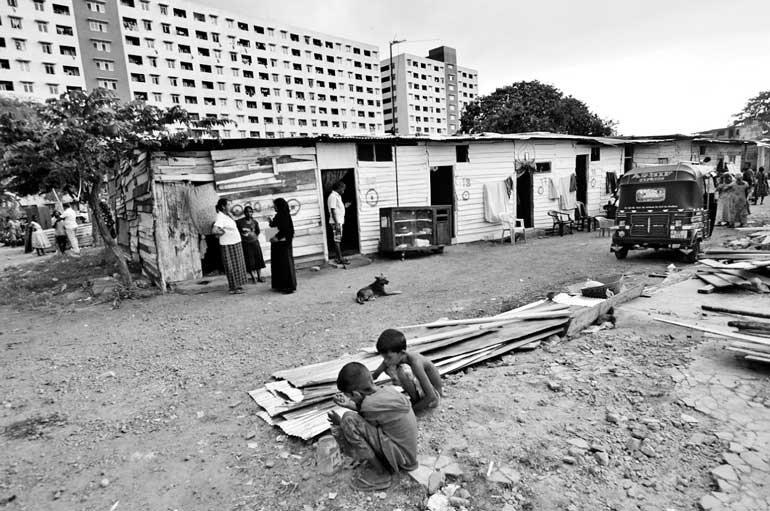Good men and women of society: Poor and marginalised need your voice of advocacy

This appeal is addressed to all good men and women of Sri Lanka, especially those younger generation leaders in the cities and rural villages, please raise voices of advocacy and publicly apply pressure to change for good and address the interests of the poor and marginalised rural householders
– Pic by Shehan Gunasekara
- Thitha aththa – the bitter truth! From published statistics and those networked with the rural villagers, the marginalised and poor rural folk
Seventy years after independence, governed by democratically-elected governments of various colours, parliamentary and presidential systems of governance, following economic policies based on capitalism, market, socialism, mixed, middle path and now social market, devolved governance and administration, appealing visions and policy pronouncements of political leaders with charisma and purported commitment, a capable executives in administration, with proven rule of law and justice systems in place, having Sri Lanka strategically located by time zones and shipping lanes, endowed with resources both physical and human, experiencing major natural calamities only rarely, and with no real external threats of aggression/pressure, a nonaligned foreign policy, boasting of a proud heritage with historical achievements, touched by the blessings of the Buddhist philosophy and all other major religions, giving residence to Sinhalese/Tamils/Muslims/Malays and Burgers and receiving global visitors as tourist hot spot and called the ‘Lung of Asia,’ whereas sadly, a majority of our citizens/the country:
- Have not reached the living standards of citizens our Eastern Asian neighbours, who some time ago lagged behind us in socio-economic shared standards
- Are subject to severe socio- economic inequality
- Are poor and fail to see a future of hope of being in a similar status to citizens of Singapore
- Yet a developing country with per capita GDP of $ 4,000
- Severe disparities in
- Regional shares of GDP with Western having 44% and Southern 11%, Central and North Western 10% and other five all around 6%, 5% or 4%
- Median monthly per capita household monthly incomes in the Western Province is Rs. 10-12000, and in Northern and Eastern Provinces Rs. 4-6,000 and all others 6-8,000
- Several districts classified with high unemployment and underemployment
- Availability of State services and infrastructure support
- 80% of the tax revenue from value based taxes impacting on all citizens and only 20% from income based taxes, thus placing severe burdens on the poor and marginalised households
- Low tax revenue to GDP
- Low savings ratio
- Low levels of Foreign Direct Investments
- As of 2012, the World Bank reported that public spending on social safety net programs in Sri Lanka decreased as a percentage of GDP from 2.2% in 2004 to 0.3% in 2009. As a result, Sri Lanka moved from being a country with relatively high safety net spending to one with limited resource allocation for safety nets.
- Sri Lanka’s main safety net program, Samurdhi suffers from poor targeting and benefit adequacy
- Growing numbers affected by or in danger of suffering from Chronic Kidney Disease
- Significant deficit budgeting annually
- Fiscal gap if computed likely to be in the red indicating bankruptcy
- Net external debt exceeds $ 50 trillion
- Have turned to the IMF for bailout support packages on several occasions
- A low growth economy
- Peace and harmony regularly challenged by ethno religious conflicts
- A 30-year-long terrorist menace has reversed growth options
- High prevalence of bribery, corruption and money laundering and the country tagged as a high risk jurisdiction
- Political stability challenged on many an occasion and has severely impacted on growth and prosperity
Visions and commitments
- Mahinda Chinthana – A Brighter Future
- Sri Lanka: The emerging ‘Wonder of Asia’
- A prosperous country; a land of plenty
- Disciplined and law-abiding society
- Comforts, convenience and satisfactory lifestyles
- Developed road network and transport system
- A unitary state, not to be divided
- Shared values, rapid development and lasting peace
- Respect for fauna and flora
- Priority for youth
- Focus on modern education and knowledge systems
- A Healthy society
- Entrepreneurs with strength to conquer the world
- Reawakening the performing arts
- People return, rather than migrate
- Vision 2025 of the Current Regime – Our vision is to make Sri Lanka a rich country by 2025. We will do so by transforming Sri Lanka into the hub of the Indian Ocean, with a knowledge-based, highly competitive, social-market economy. We will create an environment where all citizens have the opportunity to achieve higher incomes and better standards of living. To achieve this we must create the conditions which will generate economic growth with equity. The structural transformation necessary to achieve this vision is currently underway. The ‘Empowered Sri Lanka’ document laid the foundation for this transformation by identifying the priorities of raising incomes, ensuring employment and housing for all, and improving the quality of life for all citizens. We will position Sri Lanka as an export-oriented economic hub at the centre of the Indian Ocean. We recognise the fundamental reality that Sri Lanka has a domestic market of only 20 million consumers with a modest per capita income, and must rely on external demand for sustained, high, and long-term growth. We will strategically position Sri Lanka as the hub of the Indian Ocean, securing opportunities for local businesses in global production networks (GPNs). This outward-looking approach will increase the efficiency of the domestic economy, contributing to a better life for all Sri Lankans. We will stamp out corruption by encouraging competition and enabling transparency to give all Sri Lankans an equal chance at prosperity.”
Reality of the majority of our citizens, especially those in rural village households
- News 1st Gammedda Reports 2016 and 2017 concluded that “even though many rural development projects were implemented by various governments throughout the history, none of these programmes have been successful in identifying the real needs of the rural community. An attitudinal change among people should be fostered to address the gaps in development. It is only then, Sri Lanka would be able to achieve balanced as well as sustainable development.”
- The three main issues identified related to;
- Below acceptable level infrastructure, with the lack of connectivity and access via bridges and village roads to towns where education, health, other services and market opportunities are available
- Water problems dominated the next major hidden issue, with the lack of clean drinking water and water for irrigation and household consumption being major demands in all provinces
- Lack of opportunities for generation livelihoods supportive incomes sufficient for basic sustenance was the next major issue. The lack of markets for produce, lack of financial capacity for even home garden cultivation activities and in some cases the total lack of opportunities for young and old and especially female householders, to engage in economic activities were key constraints
- Thereafter a host of other key issues emerged in areas linked to lack of acceptable housing, human –animal conflict, education and schools, transportation, health land ownership challenges, consequential impact of war and natural disasters, environmental pollution and irrigation.
- The common thread that appears to run through these segments of society, equally across the island, appears to be that their needs and aspirations have not been recognised and prioritised by the State, due to the villagers being powerless and voiceless; and being unfocussed by all levels of persons in governance (village, Pradeshiya, Local Government and district level). The only focused attention appears to emerge closer to elections, where promises and commitments are freely given; but never honoured post elections
- The bottom of the pyramid citizens in rural Sri Lanka seek budgetary allocations, focused governance attention and effectively implement projects in meeting their basic needs, including;
- Adequate allocations for education to correct the present inequities ( there is significant variation in learning outcomes among provinces) including the need to improve educational outcomes in rural and estate sectors and among students from the types of schools attended by low income households;
- In war-torn areas households without homes and female headed households without livelihood supportive employment or home garden cultivation options;
- Villages, households and schools without safe drinking water, adequate competent teachers and teaching aides;
- Villages without irrigation for cultivation and water for household consumption;
- Fisher families with their livelihood options negatively impacted by development and external threats (e.g. Colombo Port City construction linked sand mining, wind turbines constructed in Puttalam, Indian bottom trawling incursions to Sri Lankan territorial waters and due to restrictions in high security zones in the north/east
- Villages impacted by the human elephant conflict
- Villages affected by Chronic Kidney Diseases
- Villages without easy access to schools, hospitals, administrative centres, markets
- Villages regularly impacted by floods and risks of landslides and other natural calamities

Villages whose sources of water supply are uncertain due to droughts and supply systems, tanks and associated canals and rivers are not in an effective system of functioning
Thitha Aththa –
The bitter truth!
Those networked with the rural villagers, the marginalised and poor rural folk assert that:
- There are in many villages those severely impacted by poverty and those due to drought, lack of water resources for farming and household elders suffering from Chronic Kidney Disease, where households manage with one meal a day and where mothers forego meals in order to feed the children
- Poverty, village low productivity and inadequate household incomes are leading to severe malnutrition
- Government focused major development projects with heavy resource allocations have very limited trickle down impact on village households and inclusivity and equity does not appear to be a priority of the those in charge of governance
- High levels of alcohol consumption and dangerous substance abuse have also led to lower household spendable incomes and productivity
- Consumption oriented and higher aspiration marketing and misrepresented credit/loan marketing promotions have led to heavy indebtedness in most village households
- The potential total population in danger of being impacted by Chronic Kidney Disease is three to four times those now identified
- The irrigation authorities and many other departments of the State have failed to address collapse of and low functionality of the total infrastructure and systems associated with the supply irrigation water for farming; and thus odd unplanned interventions in cleaning tanks and canals does not effectively strengthen the viability of the system
- Adequate research and out of the box solutions with required leadership to manage effectively the human-elephant conflict has led to both affected segments being severely impacted
- Adequate research and out of the box solutions with required leadership to eradicate chronic kidney disease and dengue is beginning to have severe impact on village households
- The migration of young and youth out of villages moving out to cities and overseas employment results in the villages comprising of elders and young and this severely impacts household income generation
- The lack of acceptable housing with sanitation is a common feature of many villages
- Acceptable schooling options that will assure educational outcomes empowering the young to become market sought human capital
- Research and advisory services with assistance in addressing post-harvest losses, enhancing value addition and linkages to distribution and marketing options not made available
- Lives and livelihoods support of village households to realise 2025 Vision have not been focused by the Government
- Limited transportation and road and bridge networks for remote villages
The elected representatives and those in political and executive governance, irrespective of party colour appear to have ignored their social contract led commitments.
This appeal is therefore addressed to all good men and women of Sri Lanka, especially those younger generation leaders in the cities and rural villages, please raise voices of advocacy and publicly apply pressure to change for good and address the interests of the poor and marginalised rural householders.

